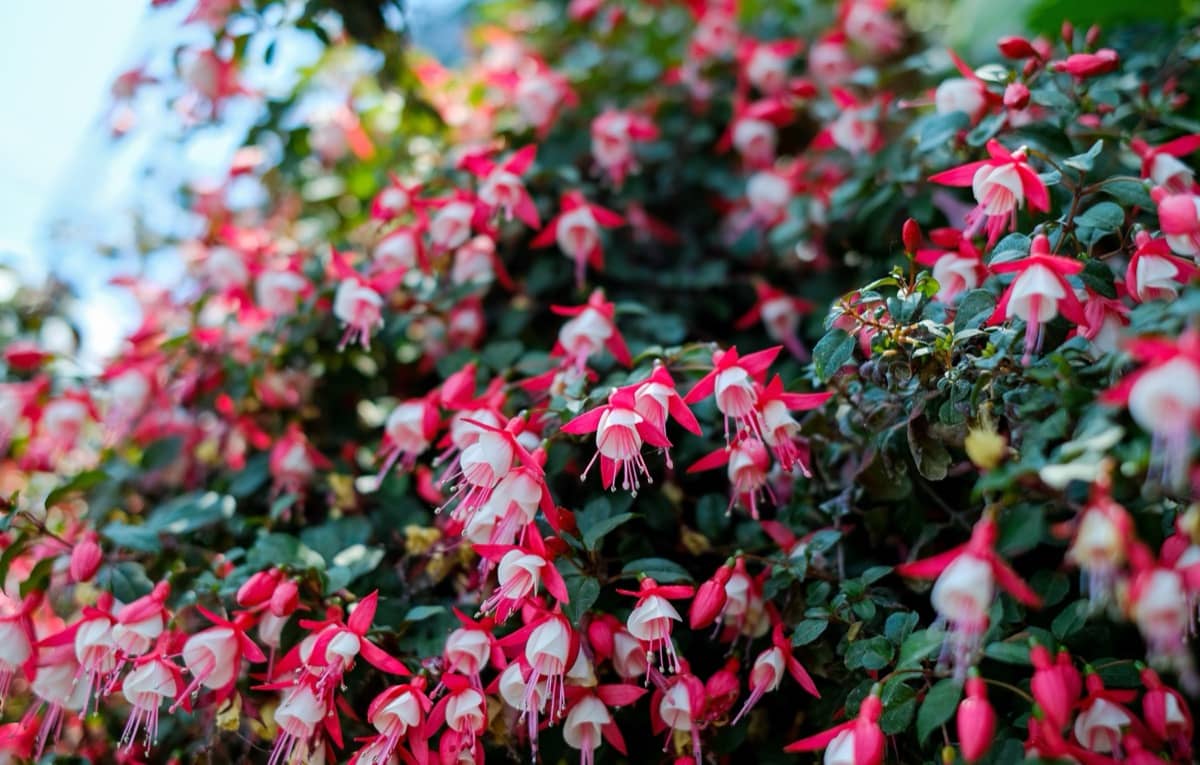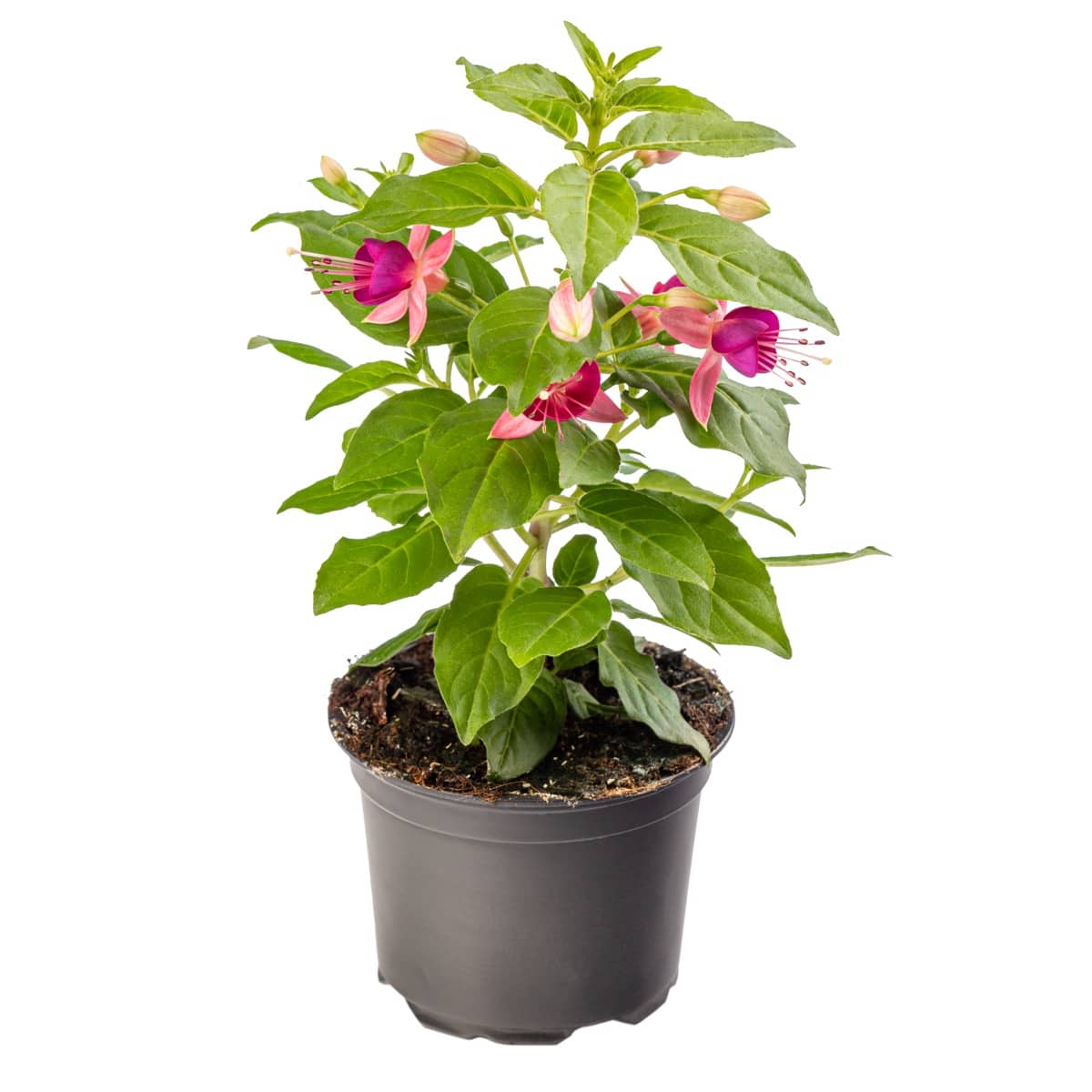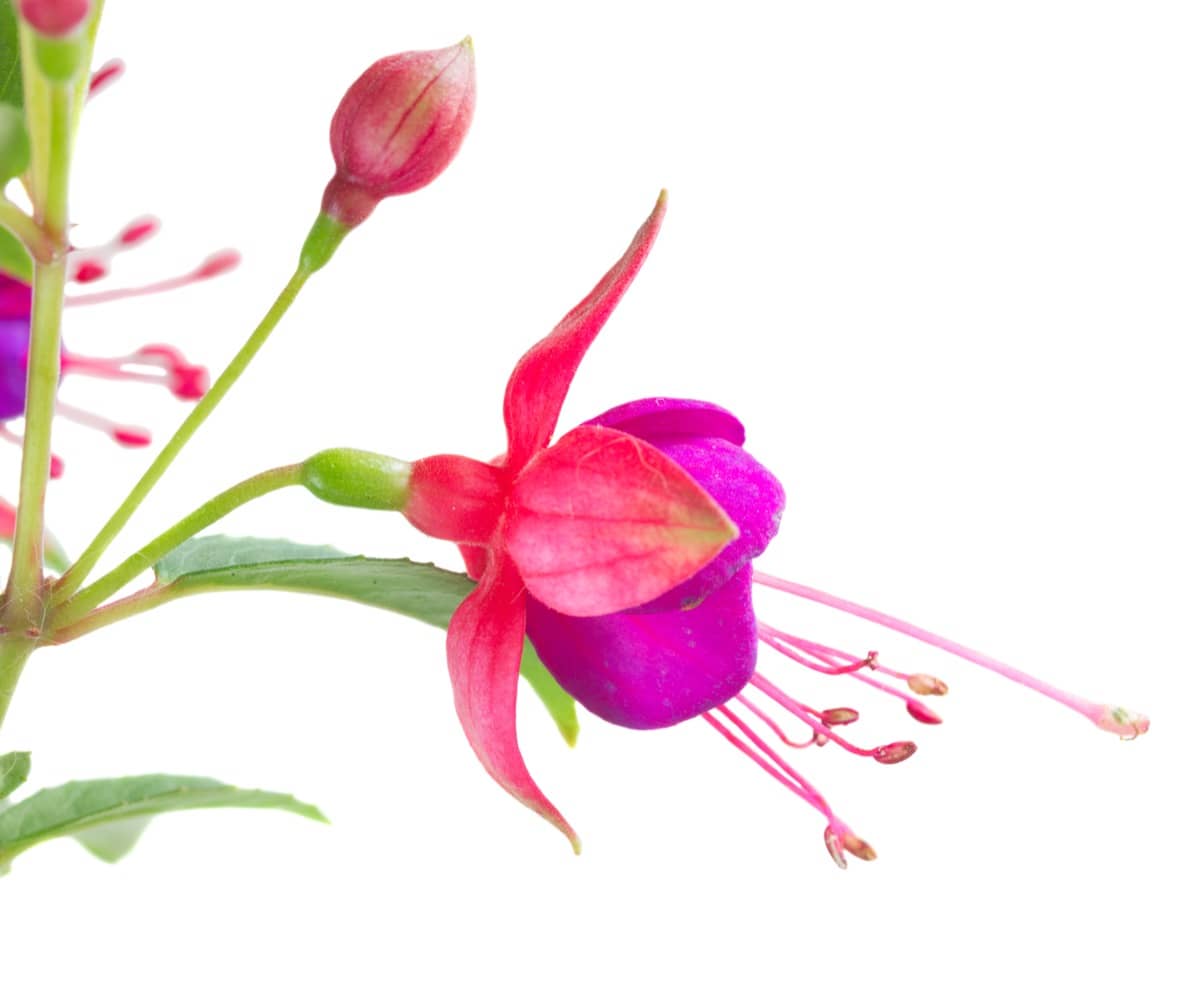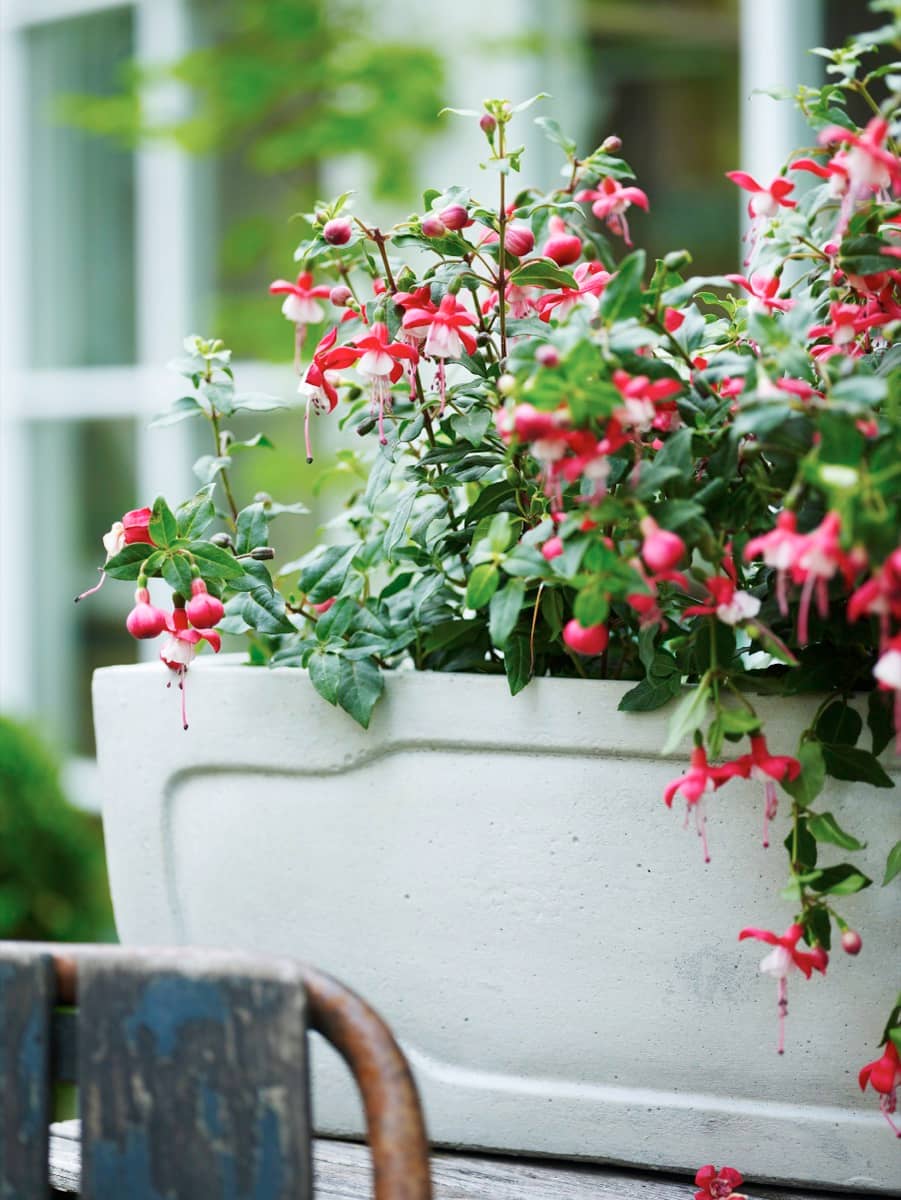Fuchsias are exquisite flowering plants that can add a touch of elegance to any garden. These delicate beauties come in a variety of colors and forms, from trailing varieties perfect for hanging baskets to upright shrubs ideal for pots. Understanding the unique characteristics of Fuchsias is essential to their successful cultivation.

Fuchsias, with their vibrant and delicate flowers, are the best choice for gardeners looking to add beauty to their outdoor spaces. One of the benefits of growing Fuchsias is their ability to attract pollinators. By planting Fuchsias in your pots, you’re not only adding beauty to your surroundings but also supporting the health of local wildlife.
How to Grow Fuchsias in Pots
Select the Right Pot for Fuchsias: Size, Material, and Drainage
Selecting the right pot for your Fuchsias is essential for their growth and overall health. Choose a pot that has enough space for the plant’s root system to develop. Small-sized pots can restrict root growth and lead to stunted plants, while an oversized pot may cause excess moisture retention. Material is another important consideration. Clay pots are popular among gardeners as they provide good drainage and help regulate soil moisture levels. However, they can become heavy when wet and may crack in freezing temperatures.
Alternatively, plastic or resin pots are lightweight and retain moisture well but may not offer the same level of breathability as clay. Opt for ones made of terracotta or plastic, as they provide good drainage and insulation. Drainage is crucial for Fuchsias since they dislike wet roots. Chosen pot contain drainage holes to allow excess water to escape freely. If necessary, add a layer of gravel or broken pottery shards before filling the soil mixture with soil to aid further drainage.
Choose the Ideal Potting Mix for Fuchsias: Nutrients and pH Balance
When it comes to choosing the ideal potting mix for your Fuchsias, there are a few key factors to consider. First and foremost, you want a mix that is rich in nutrients. Fuchsias are heavy feeders and require regular fertilization to thrive. Look for potting mixes that contain organic matter, such as compost, as this will provide nutrients for healthy growth.
In case you missed it: Blooming Borders: 15 Best Border Flowers for Your Garden

In addition to nutrient content, it’s important to pay attention to the pH balance of your potting mix. Fuchsias prefer slightly acidic soil with a pH range between 5.5 and 6.5. Fuchsias like consistently moist soil but do not tolerate waterlogged conditions well. Look for mixes that include materials like perlite or vermiculite, which improve drainage while retaining moisture.
Propagate Fuchsias from Cuttings: Step-by-Step Guide
First, select healthy and mature Fuchsias stems for your cuttings. Look for stems that are firm and not too woody or too green. Using sharp and clean pruning shears, make a clean cut just below the leaf node. Next, remove leaves from the lower half of the cutting to reduce moisture loss. If there are large leaves at the top, you can trim them in half to minimize water stress on the cutting.
Now, it’s time to prepare your rooting medium. You can use vermiculite, perlite, or a mix of peat moss and sand as your rooting medium. Fill small pots or trays with this mixture and moisten it slightly. Dip each cutting about an inch into rooting hormone powder before inserting it into the prepared pots or trays. Make sure each cutting is inserted deep enough so that only one or two nodes remain above the surface.
Place your newly planted cuttings in a warm location with bright but indirect light. Mist them regularly to maintain humidity levels around the cuttings. After a few weeks, roots should start forming on your Fuchsias cuttings. Once they have developed a good root system (usually after 6-8 weeks), you can transplant them into individual pots. Remember to keep these new transplants consistently moist while they establish themselves in their new containers.
Sow Fuchsia Seeds and Tips for Successful Germination
Sowing Fuchsia seeds is an exciting way to grow these beautiful plants from scratch. First, start by selecting high-quality Fuchsias seeds from reputable sources. Next, prepare a seed-starting mix that is light and well-drained. You can use peat moss, perlite, and vermiculite to create the perfect medium for your Fuchsias seeds. When sowing the seeds, sprinkle them evenly across the surface of the soil without burying them too deep.
In case you missed it: From Seedling to Bloom: Tailoring DIY Flower Plants Fertilizers to Different Growth Phases

Fuchsia seeds require light to germinate, so simply press them lightly and cover them with vermiculite. To provide optimal conditions for germination, place your seed tray in a warm location. Maintain consistent moisture levels by misting the soil regularly or covering the tray with plastic wrap until you see signs of germination. Once your Fuchsia seedlings emerge, make sure they receive adequate sunlight by gradually acclimating them to brighter conditions.
Transplant Young Fuchsia Plants into Pots: Best Practices
Transplanting young Fuchsias plants into pots is the best step in ensuring their healthy growth and development. Before you begin the transplanting process, make sure to select an appropriately sized pot that allows room for the plant’s roots to spread out. When it comes to choosing the right potting mix, look for one that is well-draining and rich in organic matter.
Fuchsias prefer slightly acidic soil with a pH level between 5.5 and 6.5, so consider adding some peat moss or compost to adjust the pH balance. Before transplanting, gently remove the young Fuchsias plant from its old container and carefully tease apart any tangled roots. Place it in the new pot at a depth where it sits comfortably without burying too much of its stem.
Once transplanted, water your Fuchsia thoroughly, but avoid overwatering as this can cause root rot. Keep an eye on moisture levels by regularly checking the soil; if it feels dry to the touch, it’s time to water again. To ensure successful transplantation, place your potted Fuchsia in a spot that receives indirect sunlight or dappled shade throughout the day. Avoid direct afternoon sun exposure, as this can scorch delicate foliage.
Optimal Sunlight Conditions for Fuchsias in Pots: Finding the Right Spot
When it comes to growing Fuchsias in pots, finding the right spot with optimal sunlight conditions is crucial. These delicate plants thrive best when provided with the perfect balance of light and shade. First and foremost, it’s important to understand that Fuchsias prefer bright but indirect sunlight. Direct sunlight can scorch their leaves and flowers, causing damage to these beautiful plants. So, look for a spot that receives morning sun or dappled shade throughout the day.
If you have limited outdoor space or live in an area with harsh weather conditions, consider placing your potted Fuchsias near a window indoors. Make sure they receive at least 4-6 hours of filtered light each day to keep them happy and healthy. It’s also worth noting that different varieties of Fuchsias have varying sunlight requirements. While some may tolerate more shade than others, most will appreciate a good amount of filtered sunlight during the growing season.
Water Fuchsias in Pots with Proper Frequency and Moisture Control
Proper frequency and moisture control are essential to ensure that your Fuchsias thrive. When it comes to watering, it’s important to strike the right balance. Fuchsias prefer moist soil but can’t tolerate excessive waterlogging or drought conditions. To determine when to water, check the top 2 to 3 inches of soil. If it feels dry, then it’s time to water.
In case you missed it: 11 Strategies to Make Jasmine Plants Bloom: Practical and Proven Methods

To avoid overwatering, make sure your pot has drainage holes. This prevents root rot and other issues caused by stagnant water. Additionally, using a well-drained potting mix will help maintain proper moisture levels. Water gently and evenly around the base of the plant until you see water coming out through the drainage holes. Avoid wetting the foliage excessively, as this can lead to fungal diseases.
During hot weather or if your Fuchsia is placed in direct sunlight, you may need to increase watering frequency slightly to prevent drying out. In cooler temperatures or during periods of dormancy, reduce watering but still ensure that the soil remains slightly moist. Factors like humidity levels and pot size also play a role in determining how often you should water your Fuchsia in pots.
Feed and Fertilize Schedule for Fuchsias in Pots
When it comes to feeding Fuchsias, it’s important to choose a high-quality fertilizer specifically formulated for acid-loving plants. Look for one that contains ingredients like nitrogen, phosphorus, and potassium. This will ensure that your Fuchsias receive all the necessary nutrients they need to flourish. To establish a feeding routine for your potted Fuchsias, start by applying a slow-release fertilizer at the beginning of the growing season. This will give a steady supply of nutrients over several months.
As the summer progresses, supplement this with regular liquid feedings every two weeks or so to give your plants an extra boost. When applying fertilizer to your Fuchsias pots, always follow the manufacturer’s instructions regarding dosage and frequency. It’s crucial not to overfeed them, as excessive amounts of fertilizer can cause salt build-up in the soil and damage the roots. In addition to regular feedings, don’t forget about organic matter. Adding compost or well-rotted manure around the base of your Fuchsias plants can help improve soil fertility and moisture retention.
Prune Fuchsias in Pots for Promoting Growth and Flowering
Pruning is an essential part of growing Fuchsias in pots. It can help promote healthy growth and abundant flowering. It’s important to know when to prune. The best time is during early spring or late winter when the plant is still dormant. When pruning, always start by removing any dead or damaged branches. These can hinder the overall health of the plant and prevent proper airflow.
In case you missed it: DIY Succulent Garden Designs for Limited Space

Next, thin out crowded areas by selectively removing some stems at their base. This helps improve air circulation and decreses the risk of disease. To shape your Fuchsias plant, identify strong main branches that form a sturdy framework for future growth. Trim back any weak or spindly branches that detract from this structure. As you prune, be mindful not to remove more than one-third of the total foliage at once, as this can stress the plant. Instead, spread out your pruning sessions over a few weeks if necessary.
Manage Pests and Diseases in Potted Fuchsias: Prevention and Treatment
One of the most common pests that affect Fuchsias is aphids. These tiny insects cause wilting and distortion. To prevent aphid infestations, regularly inspect your plants for signs of these pesky bugs. If you spot any, remove them by hand or use an organic insecticidal soap. Another pest that can create damage to your Fuchsias is spider mites. These minuscule creatures spin webs on the undersides of leaves and cause yellowing and leaf drop. To control spider mites, try spraying your plants with a strong jet of water or using neem oil.
Fungal diseases like botrytis blight can also pose a threat to potted Fuchsias. This disease causes grayish-brown mold to develop on flowers, buds, and foliage. To prevent botrytis blight, make sure your plants have good air circulation by spacing them correctly in their pots. Powdery mildew also affects Fuchsias. To treat powdery mildew, apply a fungicide specifically formulated for this disease according to package instructions.
Overwinter Fuchsias in Pots: Protecting Plants from Cold Weather
Overwintering Fuchsias in pots is crucial for their survival during the cold winter months. These delicate plants are not frost-tolerant, so taking steps to protect them from freezing temperatures is essential. To start, choose a sheltered location for your potted Fuchsias. Look for an area that provides some protection from harsh winds and extreme cold. A covered porch or garage can work well. Next, consider insulating the pots themselves. One option is to wrap the containers with bubble wrap or burlap to provide an extra layer of insulation.
In case you missed it: 18 Best Essential Tips on Watering Your Houseplants

This will help keep the roots protected from freezing temperatures. Another important step is to reduce watering during winter. Fuchsias go dormant during this time, so they require less moisture. Be sure to monitor the soil’s moisture level and only water when necessary. Additionally, you may consider adding mulch around the base of the pots. If temperatures drop significantly below freezing in your area, you might need to bring your potted Fuchsias indoors temporarily until conditions improve.
Support Fuchsia Growth with Trellises or Stakes: Structural Considerations
When it comes to growing Fuchsias in pots, providing proper support for their growth is essential. By using trellises or stakes, you can help ensure that your Fuchsias grow vertically and stay healthy throughout the season. Trellises are a popular choice for supporting Fuchsias as they provide a sturdy framework for the plants to climb on. Choose trellises made of materials like wood or metal, ensuring they are tall enough to accommodate the height of your fuchsia plants.
Place them near the edge of the pot so that the tendrils can easily latch onto them. Stakes are another option for supporting Fuchsias, particularly if you have smaller varieties. Use bamboo stakes or metal rods and insert them into the pot near each plant’s base. Gently tie the main stem of each plant to its stake using soft twine or plant ties.
Regardless of whether you choose trellises or stakes, it’s important to consider structural stability. Make sure your supports are firmly anchored in place and can withstand strong winds without toppling over. Additionally, keep an eye on how your Fuchsias plants interact with their supports as they grow. Regularly check and adjust any ties or attachments to prevent damage caused by rubbing against sharp edges.
Conclusion
Growing Fuchsias in pots can be a rewarding and enjoyable experience. With the right pot and soil, proper propagation techniques, and careful attention to care, you can have thriving Fuchsias plants that add beauty to your indoor or outdoor spaces. With these tips in mind, along with some patience and dedication on your part as a gardener — you’ll soon be rewarded with stunning blooms that will brighten up any space they grace.
- Organic Gardening on a Budget: Low-Cost Methods and Materials
- Gongura Seed Germination and Planting Methods
- Cabbage Seed Germination and Selection
- Broccoli Seed Germination and Selection
- Asparagus Seed Germination and Variety Selection
- Seasonal Flower Gardening: Best Practices for Spring, Summer, Fall, and Winter
- How to Grow Hibiscus from Flower
- Plantation Ideas for Home Decoration: A Beginners Guide
- Flower Garden Designs and Layouts for Beginners
- Planting and Spacing Techniques in Papaya: A Beginner’s Guide
- Growing Gold: Essential Techniques for Planting Pineapples
- How to Make Kalanchoe Plant Bushy: Home Remedies and Solutions
- 11 Reasons Why Your Gardenia is Not Blooming: Home Remedies and Solutions
- Eco Elegance: The Guide to Designing a Drought-Tolerant Landscape
- Gardening on a Slope: Strategies for Hillside Landscaping
- Nourish and Flourish: Top Organic Mulches for Thriving House Plants
- Everything You Want to Know about Indian Mogra Flower: Discover Uses and Growing
- Green Thumb Success: Expert Tips for Cultivating Greenhouse Pumpkins All Year Round
- Maximize Growth & Flavor: The Ultimate Guide to Companion Planting in Herb Gardens
- How to Control Rhododendron Problems Naturally: Home Remedies and Organic Ways to Fix Them
- Natural Magic: The Remarkable Benefits of Cinnamon for Plants
- Best Steps to Revive Dying Tulip with Natural and Organic Treatment
- 10 Reasons Why Your Angel Trumpet is Not Blooming: Remedies and Treatment
- How to Fix Periwinkle Leaf and Flower-Related Problems: Natural Remedies and Solutions
- How to Fix Zinnias Leaf and Flower Problems: Discover Natural and Home Remedies
- Organic Steps to Induce Lemon Tree Flowers: A Comprehensive Guide
- Bloom Booster: Crafting the Perfect Homemade Bougainvillea Fertilizer
- Optimizing Growth: A Guide to Applying NPK Fertilizer for Potted Plants
- 10 Best Homemade Fertilizers for Rubber Plant: DIY Recipes and Application Method
- How to Boost Female Pumpkin Flowers: Effective Steps for More Flowers and High Yields
- Transform Your Indoor Garden: Top Benefits of Pink Salt for Houseplants
- 10 Best Homemade Fertilizers for Peacock Plants (Calathea): Easy DIY Guide
- Unlock Blooms: 9 Reasons Why Your Potted Chrysanthemum is Not Blooming
- 8 Reasons Why Your Potted Hibiscus is Not Blooming: Fix it with Simple Solutions
- Unlock Blooms: 9 Key Reasons Your Potted Frangipani Won’t Flower
- 10 Reasons Why Is My Ice Plant Not Blooming: Remedies and Treatment